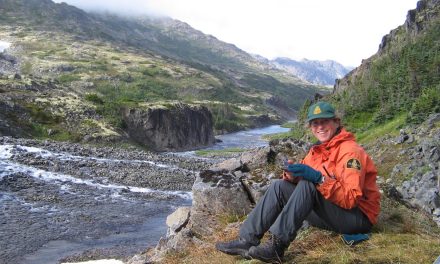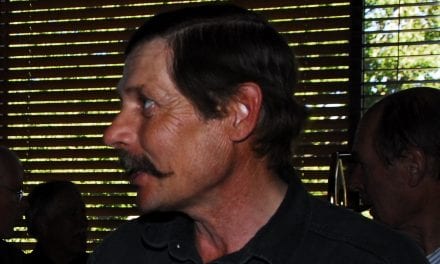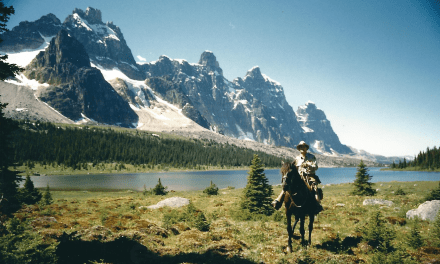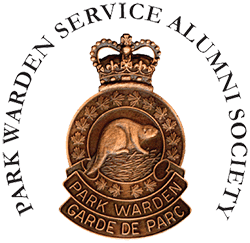3602: An event in my last year was exciting because it pulled it all together. I was working by myself in the Red Deer valley looking at aspen regeneration after the wolves there began to reduce the elk numbers. Ian Pengelly asked me to check out the wolf densite. A few years before Ian had accidentally burned up a wolf den site and killed the Alpha female with the prescribed fire, so from then he was very careful with wolf den sites. He burned around them in the fall when the wolves weren’t on them to clean up the fuels. We’d come back the following spring, by then the wolves would be there but all around the densite was burnt so they would be safe. So that spring I was out there working on my own, and Ian radioed me to light up near the densite again to help broaden out the area that had been burnt. They were going to light up the main valley over the next few days. By about noon I was out there with matches lighting the fire, and I could hear the alpha-female howling near the den. She came out into the meadow. With her were a couple of younger black wolves, two-year olds, that Dave Norcross had collared the year before. Then I see 2 other younger guys also black but not collared—they were just one-year olds. After lighting up grass and forest, I decided to go up on the hillside, lie on knoll, and watch what these wolves were doing. The alpha-female got really excited because she had been there in the den with the pack that we had been burned over a few years before. She was running around trying to convince these other guys that this was something to worry about. So eventually they ran right across the meadow in a long streaming line, and were upwind of me. Then they circled, running fast, and came back right towards me. I realized at the last second that they did not know I was there. I jumped up and started waving my hands but it was too late. The alpha female ran right around me to one side and the other two wolves that were collared also ran around me on the other side. That left the two young guys who were only one year old, but they were really big just the same. They ran right up to 20 feet of me, and they were looking at me like, “Come on mister, run for it and we will show you what we can do”. But I thought, “No I’m not running”. I’d had a paper route when I was a kid, and I knew what happened when you ran away from dogs– you just had to stand your ground. The other three wolves now behind me I wasn’t too worried about because they had all been radio-collared and were wary of people. But these two young guys, I tell you, I really had to have a word with them. I yelled at them, “You guys stop right there!” and they did stop about 15 feet from me. I looked at them and started in on a detailed 10-minute explanation about what it would do to wolf conservation if they ate the research manager for Banff Park– it would be a bad thing for wolves, also a bad thing for the research program. While I was explaining all this, they both sat down and they were very attentive and were listening to me, like they do when they are getting lessons from their mom, but after a while I could see they were getting bored so the one wolf looked at the other one and they tilted their heads as if to say, “What in the hell is this guy talking about?” and then they both stood up, and walked around me. Only then could I turn around and I looked behind me and the other three wolves were just lying down, clearly bored, and watching this whole scene take place. Then the wolves rose, and they all just kind of sauntered across the meadow towards the burning grass. Boy oh boy, for me, that was the wildest experience of my life! I actually had seen young wolves getting lessons from their parents before, but I had never done it myself, and I certainly never had to do it with much purpose. By then, a chunk of the forest was burning, so I walked into the middle of that, got under a tree, and sat down recognizing “I’m safe from wolves here now”. I even yelled at the pack: “This is my fire, and I get to sit in the middle of it.” That was during my last 6 months working with Parks Canada and it took about all my experience from my 40 years to understand what was going on there and realize it’s not such a big deal. We are all part of the ecosystem here and if you do the right thing, you’ll be fine, and if you do something stupid, you won’t be fine. And that’s how it worked out! I got tested on all my fire management training and predator/prey knowledge in a few minutes.
MH: What have done since leaving Parks Canada? 4110:
CW: After I left, in 2009 I worked with Bob Haney, Marie-Eve Marchand, Harvey Locke and Julia Lynx on the public relations for restoring bison to Banff. Bob and I worked as Parks Canada volunteers and took folks out on horseback trips into the Red Deer valley to see where the bison project might happen. Lately I have helped Parks’ bison project manager Karsten Heuer on some bison ecology issues, and that project has led onto a lot of work that I do in the States. I’m working on the edge of bison range and how many bison would have been in Yellowstone and other mountainous areas historically. Right now, I’m working on looking at New Mexico to look at the density of bison in that State and how it ties into some of the archeological sites like Chaco Canyon and the Pueblos in the Rio Grande Valley. It’s interesting to go and look at how the ecology is some ways, is quite similar to the edge of bison range in Banff where First Nations used to chase bison into the valleys and hunt them and it’s possibly a similar regime down there. It’s been fun to work on that and it ties in nicely to the experience we had in Banff and a lot of the same people I’ve worked with half my life down there in the United States parks and forest services.
MH: How did the Warden Service change over the years? 4220:
CW: It started off, like I said, with the specialization in Public Safety (Tim and Clair) and I think eventually the pendulum has almost swung too far now. I think it’s still fine in small parks where everybody shares duties but I think in the bigger parks it has gotten to the point now where clearly most of the Resource Management Wardens don’t know much about Public Safety, or maybe not much about the backcountry. The Public Safety folks certainly don’t know much about the backcountry or horse use. I think there is a real need to go back to the organization structure that Banff had in the 1990s where the majority of the Wardens were generalists and they might rotate out for a few years into one of the specialty shops but the real skill and depth of the organization was 20-30 generalist Wardens in a big park like Banff. And a small park with 10 wardens, you might have six generalists where they might all have a specialty but the core 50% of their job was working well together. It would be nice to back up from the intense Public Safety skills we have and say “No, we need a couple of people like that, but maybe we don’t need 10 full guides in Banff.” Same with Law Enforcement (maybe 1 or 2 not 10) and Resource Management too. Wardens should be able to do a bit of everything. I think there is a real need to go back to a real core generalist group, which I think the smaller parks have always maintained that over the years. It would be nice to see Banff go back to a big generalist pool so that you have more variety in your work. The whole core of the Wardens Service was that general expertise that allowed you to work anywhere in the park and travel to other parks. I think because it stayed that way in the small parks, I think the big parks might go back to it. They may see that there is a way to go back to the organization charts from the 1990s, where you have virtually the same number of staff, and then say: Well what was really wrong with that org chart? It provided employees a lot more variety because you weren’t stuck in the same whole for your entire career. It provided a broader level of skills, comradery for the staff. I really feel sorry for some of these folks who are stuck in the same job, for example law enforcement or doing mountain rescues for their entire career.
MH: What about the Warden Service was important to you? 4600:
CW: I think it was the whole gamut of what the whole Warden Service still is in that office is all important but the idea that there are many different ways to skin the cat. You have the skills especially in the big offices like Banff to tackle it through public relations, through research, through interpretation. There are just many ways to go at it. When the majority of your people are pooled and you can put the touch on someone who has a special form of expertise for a certain task. That’s what made the Warden Service in those days, a great entity. It was unmatchable in terms of: you could walk through the Banff Warden Office with a bear problem, or an escaped fire, or a rescue or some other issue and within a couple of hours, you could assemble a group of people who would likely be some of the best people in the country to tackle that. In the rugged environment of the Rockies these folks had experience using the full array of helicopters, horses, skis, or climbing ropes for whatever you have to do. You couldn’t imagine how creative these people could be because they had such a diversity of skills. The diversity of skills amongst the Wardens is what made the Warden Service great and to get back to that would be a good thing.

2005 Scotch Camp Cabin: Peter Duck (Bow Valley Naturalists), Ron Warner (Holiday on Horseback), Tom Hurd (Wildlife Specialist), Ian Syme (Chief Park Warden), Bob Sandford (Mountain Interpretive Specialist), Ian Pengelly (Veg-Fire Specialist), Cormack Gates (University of Calgary) all discussing options for bison restoration.

2009 at Clearwater Lakes: CW, Ian Pengelly, and Tom Hurd. My work compatriots for nearly 20 years.
MH: Are there any legendary characters or stories associated with the Warden Service that you can share? Is there anyone from the Service that stands out in your mind? 4730:
CW: We were lucky enough in Banff to have a real range of characters. When I first started I worked for a couple of years with a fellow called Jim Rimmer who is legendary. He was an amazing guy. I could remember my first interesting time with Jim was when we were out in the backcountry, I was with Traf Taylor and Traf explained to me what Jim would be like when he met a new Seasonal Warden. He always had an initiation routine. First, he had a “feats of strength” test, then he moved on to “skill testing questions”. These were initiation techniques Jim had learned in the British Military when he was in Saudi Arabia. We got to Indianhead Lodge and there was a rock on the windowsill there that had been left there by Jim Davies the helicopter pilot. Anyways, Jim Rimmer soon arrives. He was travelling with Tom Ross, Banff’s assistant superintendent who had also been a long-time warden that could be tough. Soon we started through “feats of strength” and Rimmer, he was strong and fast. It was game of “knuckles and knees” and I was pretty badly bruised up by the time we finished our dinner at the dining room table. There are a lot of ways to get hurt even just between two guys sitting on chairs I will tell you. Anyways, this game of knuckles is pretty hard on your hands and Jim, an ex-boxer, was very fast doing that. Then we moved onto the “skill testing questions” and I was failing badly. Jim had some really good questions about Banff Park’s ecology. But then there was this rock sitting on the window sill and we knew that Jim Davies had picked this rock up at a florite mine behind Mount Assiniboine many miles to the west. We passed that rock to Jim and said, “Jim, we picked this rock up on the trail today and what is it?” We had him stymied, I tell you. He did not know and he said, “I don’t know where this rock came from. I don’t think it’s from this valley” and he was right it wasn’t. But he never did figure out how we got it. Jim was a stubborn character. When Parks Canada set up a group of dog masters, they sent potential wardens for psychological tests and Jim was a bit too authoritarian. I think he had had a bit too much British Military Training. Anyways, they decided he might not be a good dog master and he was really mad. Jack Woledge got to be the dog master at Lake Louise and Jim thought, that’s it, I’m going to go out and get a dog and show Parks how it’s done. He raised this German Shepard named King and the dog clearly had picked up most Jim’s traits for being stubborn and difficult to deal with. One day, Jim had been training King and he wanted to show Jack Woledge how the dog was progressing. Jim comes to the office and says, “Jack I want you to come outside here. I want to show you some tricks I’ve taught King.” So we all stepped out onto the porch and King is in the back of Jim’s truck and Jim yells, ”Here King, come over here boy.” And King jumps out of the truck, takes one look at Jim and just buggers off going the other way at about 100 miles per hour. Jim had this awkward look on his face and he turns to Jack and says, “You see Jack, I’ve taught him to be independent”.
Jim was one amazing guy, Billy Vroom was another amazing fellow that had had some rescue and grizzly trapping stories that were beyond belief, but actually true. And at coffee every day, just a whole cast of characters from Dave Norcross to Al Mcdonald, Gord Irwin, Mark Ledwidge, Tim Auger, Perry Jacobson, Don Mickle, Tom Hurd, Ian Pengelly, Ian Syme, Reg Bunyan, Diane Volkers, Clair Israelson, Julie Timmins, Helene Galt, Chris Worobets… many more. Just exceptional people to work with. Oh yeah… Ronnie Leblanc and his hot spoons, or Frank Burstom with a 1-inch long cigarette ash. It was always great fun at the Thursday morning meeting.
MH: Is there anything about the Warden Service, as you knew it, that you would like future generations to know?
5130:
CW: I’ve made my pitch to say that hopefully that generalist role will continue to come back into big parks like Banff and that I am glad it is staying in smaller parks. I still talk to a lot of resource conservation staff in the smaller parks and they haven’t changed that much. There is still that same things that have to be done every day in those parks for 50 years now. Keeping wildlife where it needs to be, looking after people, doing a bit of Law Enforcement for the difficult things, but in general nothing else has really changed. The average person is a little more urbanized but being a warden in those parks hasn’t changed much since they were established and it’s neat to see that. I think that Banff and Jasper could probably go back towards having more generalist wardens.
MH: What made the Warden Service such a unique organization? 5240:
CW: I think it was the idea that you just knew, and it had always been that way, that that a Warden wasn’t going to be in the office very much and you were going to have to trust them when they left the door. They were going to be gone and you might only see them, in the District system, an hour every six months and the Chief Park Warden didn’t really want to see them more than that really. Like they said, if they showed back up in town, the chief would say: ”If you’re here looking for your horses here, there sure as hell not in my office.” So I think that was a great thing about the job was you realized there was a whole bunch of very independent people that could handle a lot of diversity and if they needed help, they’d call you but they most likely weren’t going to need much help because they all had great skill sets. I guess everyone including the dispatchers know that when you sent folks out they were going to get the job done, it might get done differently but it’s going to get done.

1994: Charles leading Peter on the Horseshoe Lake trail in the Red Deer River Valley.
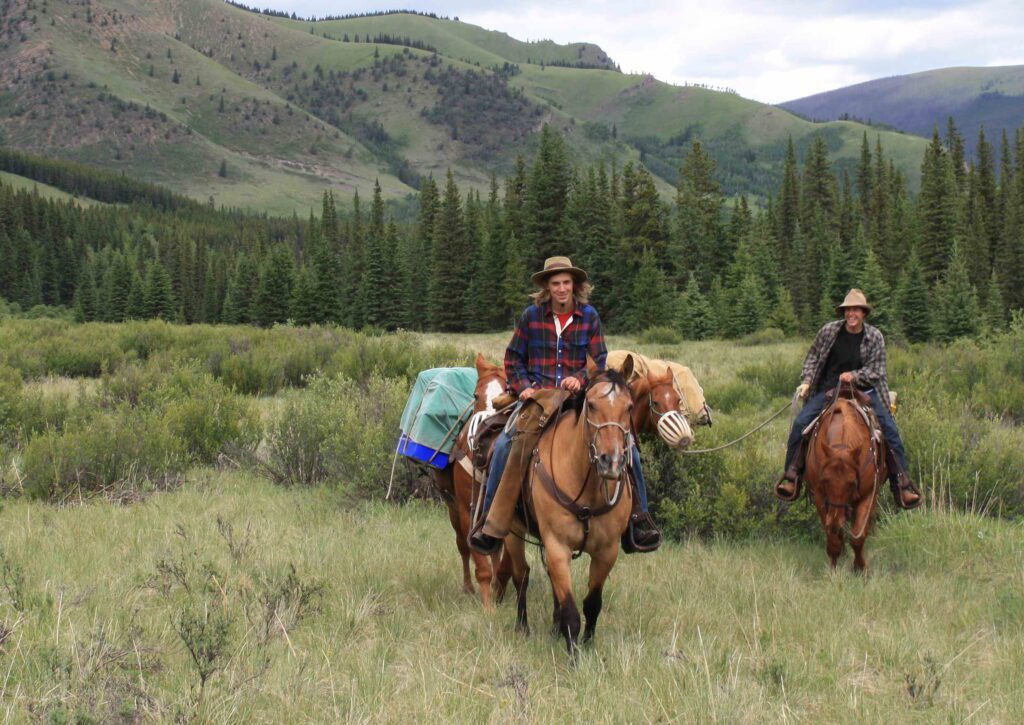
2009 Corners Area of Panther Valley: Charles and Peter packed in the supplies while I did vegetation transects for the bison restoration project.
